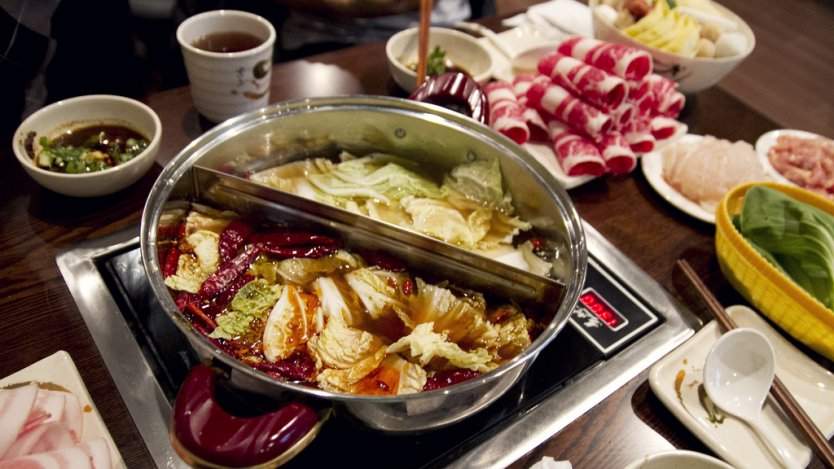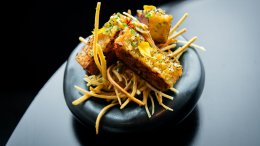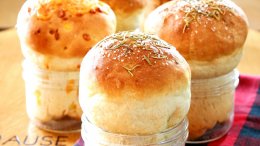Undoubtedly, mac ‘n’ cheese and chili con carne are especially satisfying when the mercury dips, but there’s another meal idea that you really should explore — hot pot.
What is Hot Pot?
Think of it as Asian fondue where everyone at the table cooks their own food in a communal pot of simmering broth. Sure, your clothes will smell and barely fit over the food triplets after the meal, but you’ll have feel like a furnace in the -20C weather, not to mention have an excellent time with friends (hot pot is not exactly a one-person event). Whether you decide to host a hot pot dinner at home or go out for AYCE (complete with cheap import beers), you’ll want to familiarize yourself with the tools and hot pot ingredients beforehand.
Tools
Before you even think about the hot pot ingredients, make sure you have all the necessary equipment. You’ll need a table top butane burner, because you can’t have eight people standing around the four-burner stove under the hood fan in the kitchen. Of course, you’ll need extra gas cannisters because they sense happiness and will run out of gas at the height of the dinner.
Vessel
The divided stainless steel pot is likely the best bet, although you can still find the traditional pot with the “chimney” in the centre.
Chopsticks
Ideally two pairs per person — one for cooked food and eating, the other for handling raw food. It helps to use disposable chopsticks for the raw food so you don’t get them mixed up, and there’s less double-dipping and less to clean up.
Strainer with handle
One per person. With everyone dropping their choice of food in the pot, you’ll want to keep track of what’s in the soup, unless you like to hunt for rubbery mussels and leathery beef.
Broth/soup
Most restaurants offer many options, and between four people, you’ll likely be sharing two soups in a divided pot. It’s a good idea to keep one mild and the other spicy. Most restaurants use packaged soup bases for convenience, but if you’re hosting the hot pot party at home, you can make the soups from scratch with less salt and more natural ingredients. You’ll want soups on the bland side, as the continuous simmering and boiling, as well as the addition of meats and other ingredients throughout dinner, will concentrate the soup and make it potentially too salty and strong.
Chicken broth
It’s the most basic soup of light chicken broth and some veggies. It’s also used to top up other soups in the pot as they evaporate.
Tom Yum
A Thai influenced soup made of lemongrass, chili peppers, fish sauce, galangal, lime juice and lime leaves. It’s hot and sour, and perfect for flavouring meats.
Ma la (Szechuan)
Earthy, hot and full of spices and aromatics, this is one of the most popular soups for hot pot. It’s loaded with tongue-numbing Szechuan peppercorns, chilis, ginger, scallions, cinnamon, anise and fennel that flavour meats beautifully. If you can handle heat and you are not using a divided pot, go for this soup.
Condiments
The condiments is a mini-buffet on its own. Each person mixes his or her own dipping sauce from the array of sauces, herbs and aromatics that’s offered. This sauce, in addition to the broths, is what flavours the meats, veggies and noodles. So, if anyone says hot pot sucks, you can bet that they screwed it up.
Here are some of must-have offerings.
Soy sauce
A prerequisite for hot pot, it’s the base of the sauce you will build. If you’re out of it, go get some from the store, or ask your neighbour for it. A soy-sauce less hot pot party is not an option.
Peanut sauce (satay)
A Southeast Asian condiment made with ground roasted peanuts and spices. It's a thick sauce that is delicious on its own or mixed with other sauces.
Herbs and aromatics
Chopped garlic, ginger, scallions, cilantro and chilis all go well in a dipping sauce. How much of each to use is completely up to you.
Chili oil/paste
From chili oil to sweet chili paste, there are many various kinds of chili sauces with different nuances and heat level.
Tahini (sesame paste)
Use a little less than sauces like Hoisin or soy, but it pairs especially well with Hoisin sauce and chili sauce.
XO sauce
A Hong Kong invention, the sauce borrow its name from extra old Cognac, denoting its prestige and luxury. It doesn’t have gold flakes or truffles, but it does have big-time ingredients like cured ham and dried seafood. If you use this, it’s best not to adulterate it with too many other sauces, herbs or flavourings.
Eggs
So, you know how Rocky drinks raw eggs? Yeah, don’t do that, but try cracking an egg (unless you are pregnant or have a condition that prevents you from doing so) in the dipping sauce. It creates a smooth consistency and tones down the saltiness of the mixture.
Meat
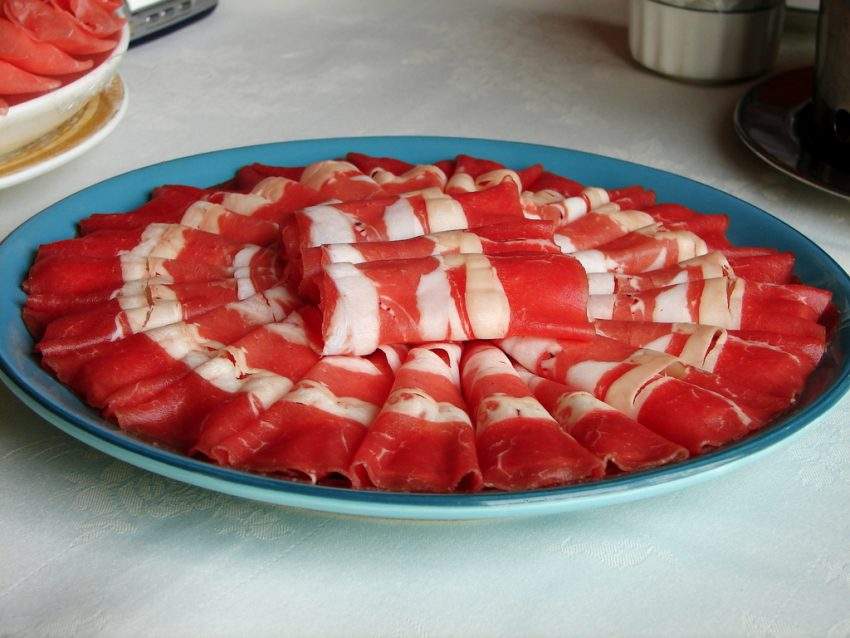
Essential to a hot pot dinner, thinly-sliced meat is the star of the event.
People will riot if thinly-sliced beef isn’t offered at a hot pot dinner, so if you’re hosting, triple check to make sure you have enough. If you are at a restaurant, you’ll want to order lots of this. After beef, lamb is the second most popular meat at hot pot. Both thinly-sliced beef and lamb cook quickly, about a minute, until there’s no pink left.
Chicken is always offered, but its longer cooking time deters impatient guests, so it’s usually not the crowd-pleaser.
Regardless of what meat you choose, the good news is, if you’re hosting the party, you can easily find packages of pre-sliced meats at Asian supermarkets in the freezer, so it significantly cuts down on prep time and mess.
Seafood
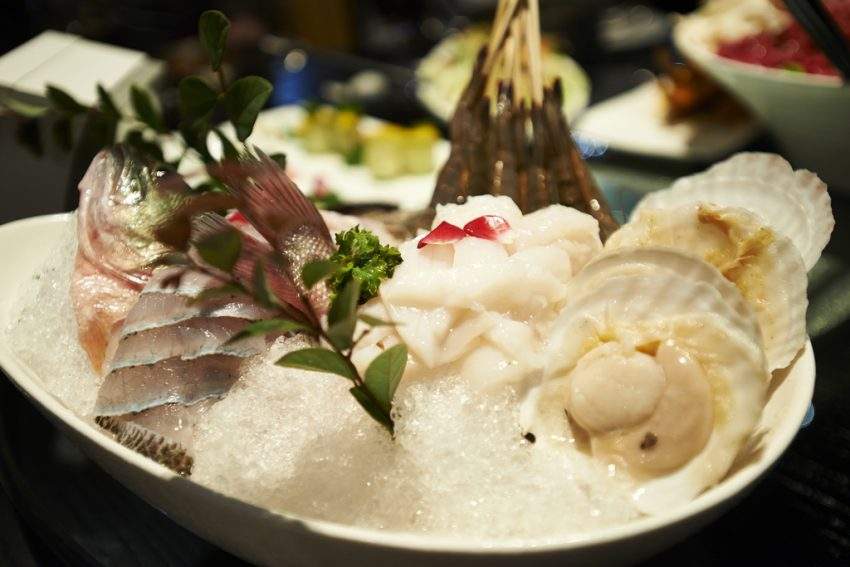
Whole, unpeeled shrimp is extremely popular, mostly because it doesn’t take long to cook. Another bonus is that the shells and the fat in the head flavour the broth and makes it perfect for noodles near the end of the dinner. The downside is that most people are too lazy to get their hands dirty and peel the shrimps throughout dinner.
Shucked oysters, scallops and mussels (cooked), squid and sliced fish are all great options for those who don’t want to eat too much meat.
Balls
Meatballs, that is. At all-you-can-eat hot pot restaurants, there’s usually a whole section of the food station that’s full of these. Regular selection includes: beef, squid balls, fish (boiled or fried), shrimp, pork, beef tendon.
These are cooked until they puff up (seafood balls will expand to the size of golf balls, while denser beef and pork balls will only puff up slightly), about five mins. Add these in the pot at the beginning so they get a head start and soak up some of the soups’ flavours. This is not really a cook-your-own type of food, so add lots into the pot throughout the meal and share.
Vegetables
Mushrooms
Shiitake, enoki, button, you name it; they are all great at picking up the flavours from the soup. If you have vegetarians in the group (who will need their own half of the pot), you’ll want to offer a healthy selection of these.
Turnip/daikon radish
Cut into big chunks, turnips or daikon radishes cook quickly and absorbs all the flavours. Just don’t leave them in for too long, or else they disintegrate into the soup and you won’t be able to find it.
Tofu/bean curd
Soft, firm or fried tofu and other soy products, like bean curd, are great ways to lighten up the meal and should always be available.
Taro
Taro root is cut into bite-size pieces for hot pot. Like daikon radish, taro breaks down if it cooks for too long, so you don’t want to put too many pieces in and forget about them, unless you want a muddy and thick soup.
Leafy greens
Vegetables like spinach and watercress are convenient because they take no time to cook. However, they pick up a lot of the salty soup, so make sure you don’t leave them in for too long.
Hardy greens
Napa cabbage and bok choy are all excellent for hot pot because of the thick stems. They can be cooked for a long time without falling apart. And, unlike leafy greens, they won’t pick up too much of the soup, so they won’t be too salty.
Starches
Noodles like udon, vermicelli and chow mein are staples, and are great for picking up that soup, which has been simmering for hours and saturated with the essence of the meat, seafood and veggies. Drop them in near the end of the meal when the soup is at its most flavourful. Be careful not to eat too much of that, though, as the soup could be very oily at this point.
A tasty, healthy and low carb alternative to regular noodle is yam noodle bundles or shirataki noodles. These chewy and gelatinous noodles, originally from Japan, come in different shapes and don’t really absorb liquid or turn soggy, which is perfect for holding up its texture in the soup. As tempted as you may be to fish them out soon after you put them into the broth, don’t! Wait a while for the broth to get into the nooks of the bundles.
Miscellaneous
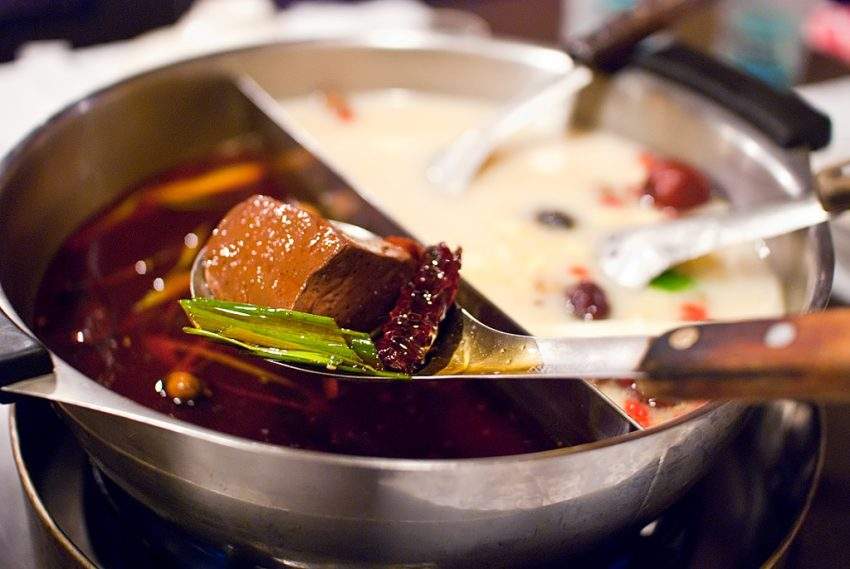
This is the part that really freaks people out. There will likely be a few things at the food station in the restaurant that looks really odd and unappetizing, namely: pig skin, blood tofu and other organ meats.
Blood tofu is coagulated blood (usually from a pig), a traditional food that is often put in congee and other stews. It doesn’t really taste like anything, but if the idea is enough to make you gag, don’t say we didn’t warn you.
Drinks
You didn’t think we’d cook up a list like this without suggesting drinks, did you?
The hot pot experience isn’t complete without Tsing Tao beer, a crisp pilsner from China. Any other pilsner would work well at cutting through the richness of the meal.
For non-drinkers, sour plum tea or suanmeitang, made with smoked sour plums and other herbs, is believed by herbalists to aid in digestion and help restore your body’s temperature equilibrium.

